
Death Valley For New Year's Eve, 2009-2010
Page 1 of 3
| You'll need to shake the sand out of your shoes after checking this out. Come with Lisa and I as we usher in the new decade by experiencing towering sand dunes, strange castles in the middle of nowhere, otherworldly landscapes, fiery red sunsets, and haunted hotels with a one-person opera show still going for over 40 years. Come with us as we explore Death Valley. |
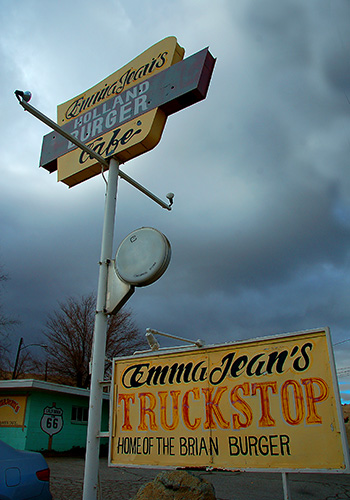 Emma
Jean's Holland Burger is a beacon of bacon and burgers, featured on the Food
Network's "Diners, Drive-Ins, and Dives", deemed a historical landmark, and
for decades, a refuge for hungry truckers making their way along Route 66 in
the mighty Mojave. Emma
Jean's Holland Burger is a beacon of bacon and burgers, featured on the Food
Network's "Diners, Drive-Ins, and Dives", deemed a historical landmark, and
for decades, a refuge for hungry truckers making their way along Route 66 in
the mighty Mojave.Gettin' our Kix on Route 66.
Yeah. |
 Shawna,
the owner/waitress, greeted us heartily. Everything made in front of
you from scratch, I ordered the Brian Burger. You take a grilled half-pound burger, melt creamy Swiss Cheese, add a couple
of grilled Ortega chilies, and stuff all that between two thick slices of
sourdough bread that's been grilled in butter and parmesan cheese. Shawna,
the owner/waitress, greeted us heartily. Everything made in front of
you from scratch, I ordered the Brian Burger. You take a grilled half-pound burger, melt creamy Swiss Cheese, add a couple
of grilled Ortega chilies, and stuff all that between two thick slices of
sourdough bread that's been grilled in butter and parmesan cheese. |
 Got
off the 15 at Baker, and headed up to Death Valley Junction and the historic
and allegedly haunted Amargosa Hotel, where we'd stay for the evening. Got
off the 15 at Baker, and headed up to Death Valley Junction and the historic
and allegedly haunted Amargosa Hotel, where we'd stay for the evening.Death Valley Junction grew from a tent town to a borax mining town in the early 1900s. Now, it's a desert ghost town, population three.
|
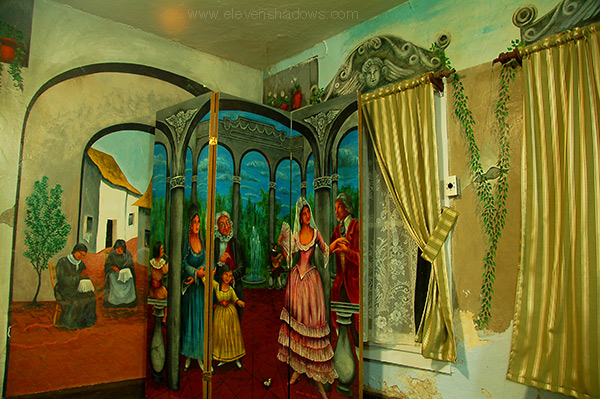 Left:
The painted dining room of the Amargosa Hotel. Left:
The painted dining room of the Amargosa Hotel.The Opera House and the hotel were constructed in the 1920s by the Pacific Borax Mining company, who built the town to accommodate its mine workers. An uninhabited area of the hotel is said to contain hauntings. Guests and workers have reported phantom smells, to the sounds of babies crying to full bodied apparitions. Lisa and I heard murmurings during the night, but alas, these were simply people walking past. We felt cold spots, but really, the entire hotel was cold. The next morning, I took a tour of the Opera House with Amber, the supervisor for the Amargosa Hotel. |
 She bought the place, went to NY to collect her belongings, moved to Death Valley Junction, and has never been back to NY since. She singlehandedly restored the Opera House for her solo performances, further repairing and painting it after a flash flood. Attracting audiences to a ghost town miles into the harsh desert is no easy feat. When Marta first began, she'd perform for audiences of one. Undaunted, she simply painted an audience on the wall. Amber said that Marta was now 85, and had recently broken a hip and had stopped performing for the moment. I found her story and achievements inspiring, and would love to see her perform. Let's hope she does. |
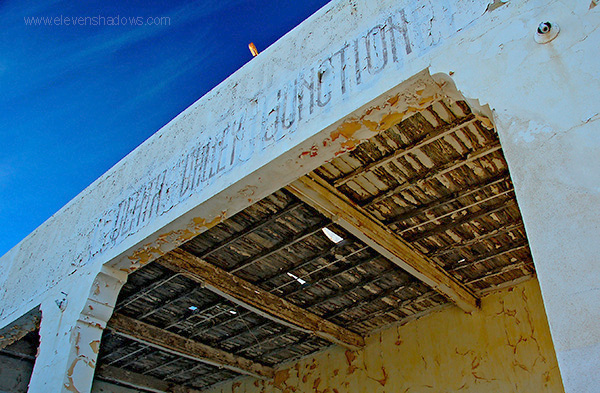 I
walked across the highway to visit the old filling station and garage of the
desert ghost town, population three -- and that number includes the Dancing Diva of Death
Valley Junction, Marta Becket, 85 years of age. I
walked across the highway to visit the old filling station and garage of the
desert ghost town, population three -- and that number includes the Dancing Diva of Death
Valley Junction, Marta Becket, 85 years of age. |
 After
a home-cooked breakfast at the Amargosa Cafe, Lisa and I continued into
Death Valley National Park, first visiting the otherworldly badlands of
Twenty Mule Mule Team Canyon, named that for the mining of borax. After
a home-cooked breakfast at the Amargosa Cafe, Lisa and I continued into
Death Valley National Park, first visiting the otherworldly badlands of
Twenty Mule Mule Team Canyon, named that for the mining of borax. |
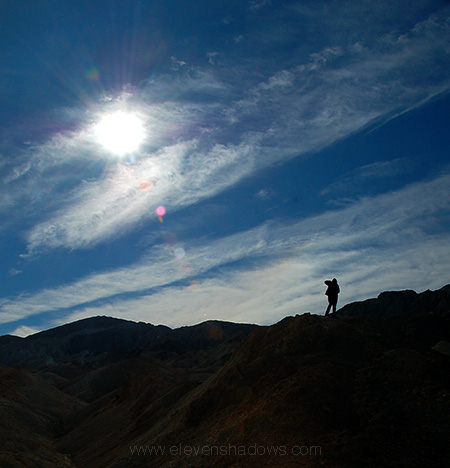 Lisa
exploring the hardened sand dunes of Twenty Mule Team Canyon, along the 2.8
mile twisting dirt road. Lisa
exploring the hardened sand dunes of Twenty Mule Team Canyon, along the 2.8
mile twisting dirt road. |
 The
wonderful silence of the desert. Twenty Mule Team Canyon, Death
Valley. The
wonderful silence of the desert. Twenty Mule Team Canyon, Death
Valley. |
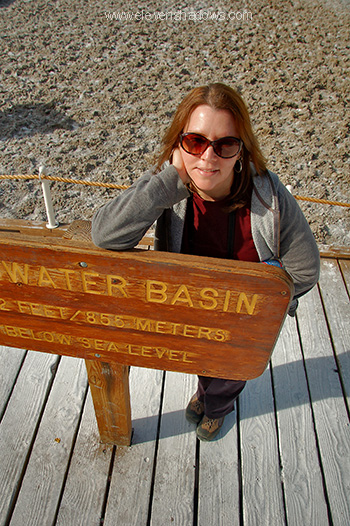 The
highs and the lows of Death Valley. The
highs and the lows of Death Valley.The highs? Death Valley holds the record for the highest (reliably reported) temperature in the Western Hemisphere, 134°F (56.7°C). The lows? Badwater Basin in Death Valley has the lowest elevation in North America, 282 ft (85.5m) below sea level. Lisa had been sick, but the moisture-starved desert air healed her up in no time, ironic for a place called Death Valley.
|
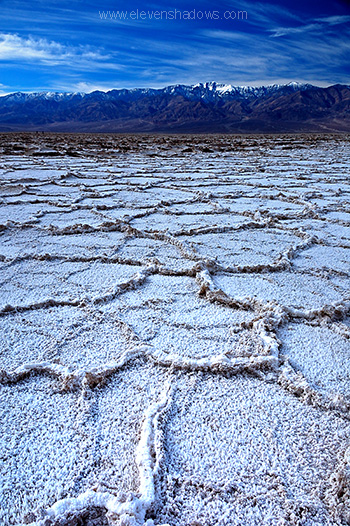 Badwater
Basin is the lowest point in the U.S. but is bracketed by tall mountains.
Mt. Whitney, its tallest point (in the 48 continguous states), is just
barely more than 70 miles away. Badwater
Basin is the lowest point in the U.S. but is bracketed by tall mountains.
Mt. Whitney, its tallest point (in the 48 continguous states), is just
barely more than 70 miles away.How did this happen? It's a fascinating combination of large blocks of bedrock sinkiing and seismic activity shoving the surrounding Panamint and Amargosa Mountains up good and high. And for added interest, add intense heat and volcanic activity, and you have Death Valley. The shimmering white expanse of Badwater Basin.
|
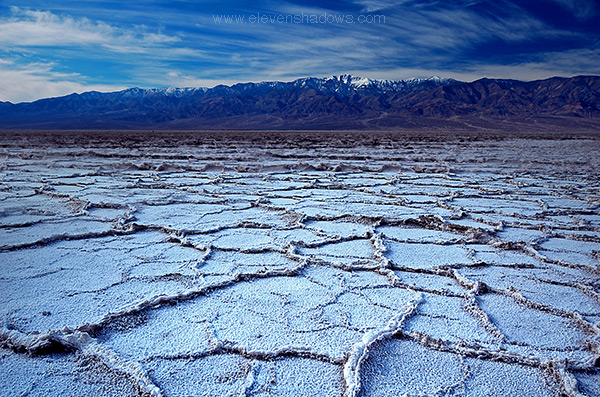 Death Valley wasn't always dry. 2000 to 4000 years ago, streams from the nearby mountains filled Death Valley with 30 feet of water. However, the climate warmed and the rain virtually stopped, drying up the water, and leaving concentrated minerals and salty pools. The salts crystallized into a thick 3-5 ft. crust on the basin floor, with billions of crunchy salt crystals. Another look at the crystallized salt floor of Badwater Basin.
|
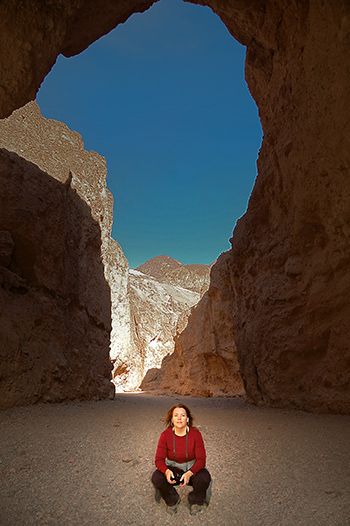 Lisa
underneath a natural bridge that was formed from an old waterfall. Lisa
underneath a natural bridge that was formed from an old waterfall. |
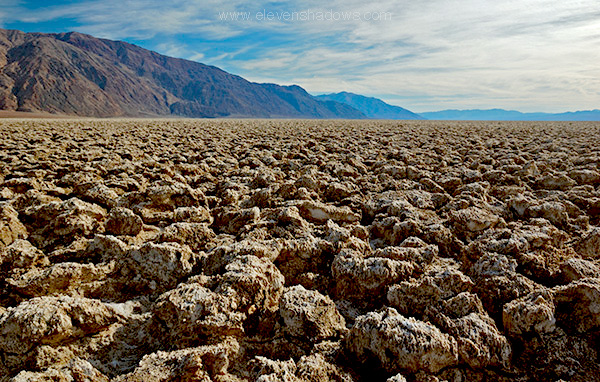 The
Devil's Golf Course is a large salt pan in Death Valley National Park, its
rough surface formed of large salt crystals in the same manner as the
Badwater Basin. It was named after a description in a 1930s National Park
Service guidebook to Death Valley, which stated that "only the devil could
play golf" on its surface. The
Devil's Golf Course is a large salt pan in Death Valley National Park, its
rough surface formed of large salt crystals in the same manner as the
Badwater Basin. It was named after a description in a 1930s National Park
Service guidebook to Death Valley, which stated that "only the devil could
play golf" on its surface. |
Death Valley, California 2009-2010
Page 1 of 3
Eleven Shadows Travel Page
Contact photographer/musician Ken Lee